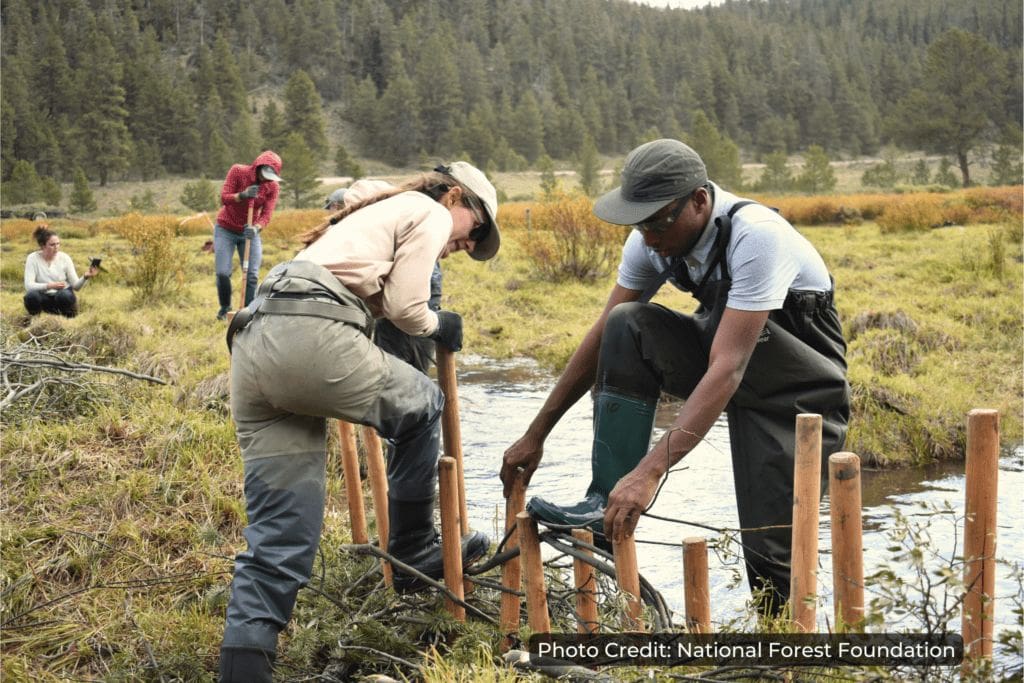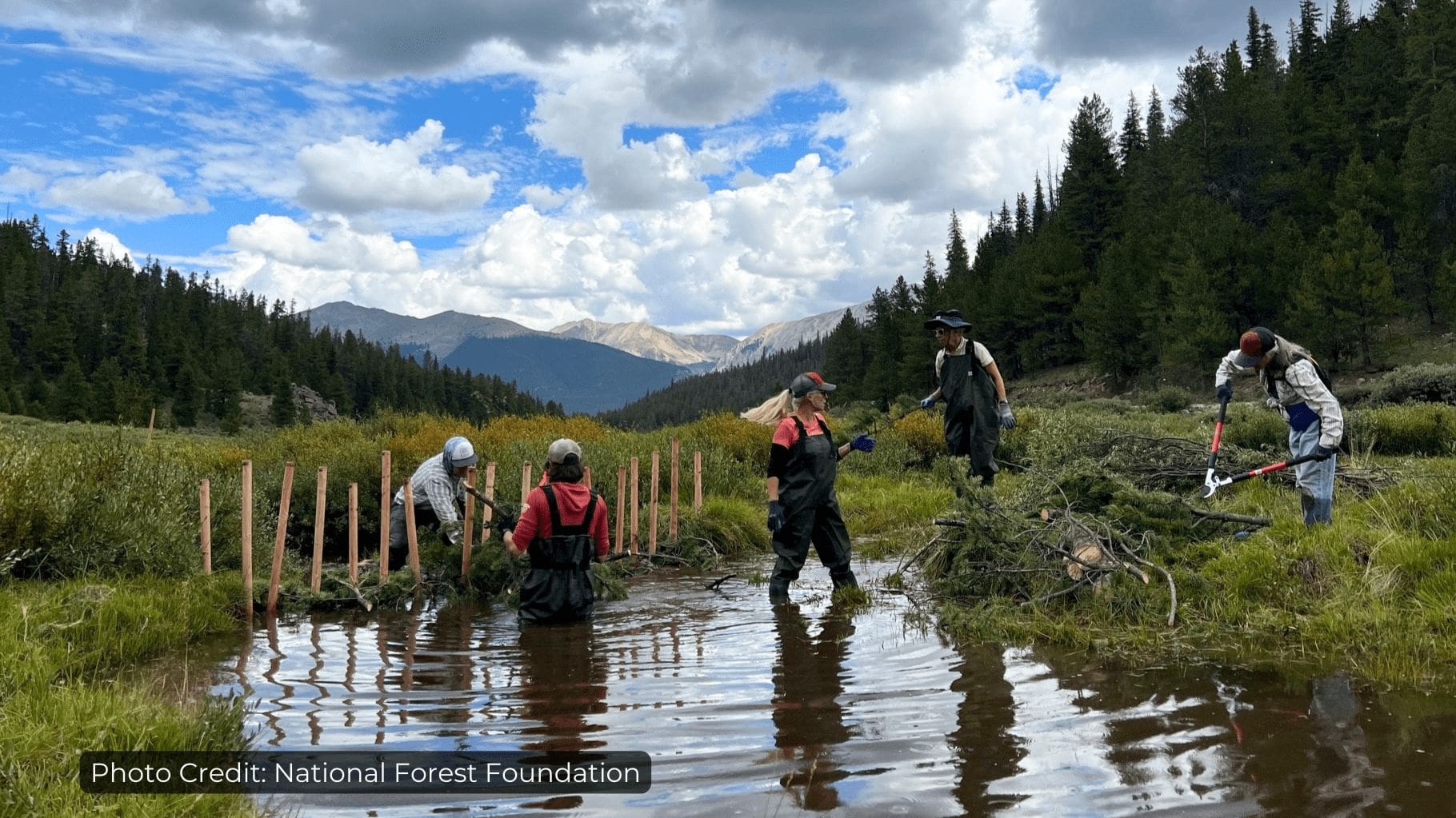Multiply decades of overuse with a hotter, drier climate and you’ve got a crisis on the Colorado River.
100 years ago, the Colorado River compact was all about controlling nature. Today’s solutions require us to think more holistically, to work with nature to allow water to slow down and soak into the landscape. As we consider how to respond to historically low reservoir levels and where to spend historic federal funding, the kind of local solutions we need to scale up for long-term sustainability don’t always make it into the headlines.
Last week, we hosted a media briefing and our panel discussion flowed from high-elevation headwaters, through forests and meadows, watering farmland along the way, to Salton Sea and urban centers to hear from experts about how they are working with nature and pursuing multi-benefit strategies across the Colorado River Basin.
Felicia Marcus, visiting Landreth Fellow at Stanford’s Water in the West, shared the birds-eye view of opportunities for the climate and water sectors to work with nature, and each other:
“Dealing with land-based emissions, both from things like deforestation as well as wildfires and the destruction of meadows and agricultural lands… managing [the land] more effectively and working with nature more effectively, we could meet up to 37% of the carbon reduction load that we need to have.
“We’ve gotta think about this whole suite of landscapes from top to bottom of the watershed… There’s a linkage between our lands at the bottom and our forest and meadow work at the top. The problem with our setup is that we manage these things in isolation, but there are efforts at the state [level] that are making a difference.”
Carina Bracer, Director of Conservation Finance and Natural Climate Solutions with the National Forest Foundation, told us about how their work in high elevation forests supports clean water while reducing fire risk:
“There are clear and measurable benefits both to the ecosystems themselves and also to society from the impact of healthy forests… [Upper elevation] lands in the National Forest area represent about 20% of the total land area of the Colorado River Basin, but, more or less, 60% production of water for the entire river Basin. So it’s a much smaller land area with a very big impact on the amount of water that is generated, the quality of that water… The increased wetness in the forested areas, have a healthier environment and mitigate fire risk and also reduce the severity of fires.
“[The Trail Creek Project] is one of our first projects using low tech — it’s called “Low-Tech Process-Based Restoration,” a very jargon-y word, but it’s essentially an approach where we’re working with beavers…

“The project started in 2021, and then in a very, very short time, in fact, even weeks after you install, these beaver dam analogs already have a very big water impact visible immediately. The resilience of this previously degraded ecosystem returns pretty fast. We are already able to see the improvement in water quality and return of the wetlands as water is flowing much slower. We’re really excited to see what’s going to happen this winter with the snowpack and what the sustainability of this wetness is in the upper elevation.”
Kern Collymore, co-founder of Sixth World Solutions, spoke about water-wise farming in the Southwest and the importance of respecting and investing in Indigenous communities:
“When you look at the people doing the work on the front lines of this, the new word is regenerative agriculture, its traditionally been local communities, Indigenous Tribes, frontline peoples who are doing these works. There was recently a study that said 80% of the world’s biodiversity is being overseen by Indigenous Tribes. As we were mentioning forest management and forest fires, that was something that these tribal communities had been incorporating but were forced to stop, right? But we see how sometimes if tribal communities aren’t on the front lines of the creation of these solutions, they kind of fall short.
“There’s been no research that shows that watering your plants at night is any less beneficial. And then your plants have so many more hours to drink. These are like on the ground solutions that we’re seeing people implementing. Being in the Southwest, in some of these desert communities, people put up these shades, these huge shades, over their greenhouses, which allows them to grow longer… These are the on-the-ground solutions, these decentralized solutions, being done across the board.
“It wasn’t until 2018 that the US Farm Bill acknowledged dry land farming as a type of farming. These are ways that Indigenous peoples have been using for millennia. So when people who are creating rules and creating laws don’t even see these systems as viable, that’s why it’s really important to make sure that these communities and Indigenous peoples are on the front lines as we’re making these rules, as we’re talking about what this future looks like, because these communities have been doing it for a long time.”
Frank Ruiz, Salton Sea Program Director with Audubon California, talked about the Bombay Beach Wetland project:
“We identified wetlands next to the community of Bombay that can be expanded, that can be enhanced, that can have multiple benefits. The purpose of our approach is to create a multi-benefit approach that will provide habitat for the birds, for Pupfish, for wildlife.
“In addition to that… we’re trying to expand the wetlands that we enhance to protect it from invasive species, such as tamarisk, or erosion, so we can also provide additional benefits. And one of them is suppressing dust. That is one of the biggest problems here in the area. In addition to that, we also want to engage communities especially communities that live around the Salton Sea and provide education opportunities for the young kids.
I don’t want to create environmentalists, I want to create leaders that understand that the ecosystem is very intrinsically related to the economy, to public health.
Catlow Shipek, Policy and Technical Director with the Watershed Management Group, explained what it means to go “hydro-local” and how their organization is changing the way Tucson stewards local water resources:
“Green infrastructure is using natural features to slow, sink, and infiltrate rainwater and stormwater close to the source. We can think of it as rain gardens at homes, stormwater basins and swales along streets… and restoring our floodplains. By increasing our investment in rainwater and stormwater as a water resource, we realize we can nearly double our local supplies and couple that with demand strategies, we can really start to achieve true water resilience as a community.
Watershed Management Group coined a fun term that we like to call going ‘hydro-local.’ This is really thinking about how we steward and wisely use our local renewable water resources, rain water, stormwater, gray water treated effluent, instead of sucking distant watersheds like the Colorado River dry.
“Green infrastructure can really help to nearly eliminate outdoor potable water demands. Green infrastructure can enhance storm water infiltration to recharge shallow groundwater areas of our watershed. Green infrastructure can combat urban heat stress through increased urban forest canopy coverage, especially in historically under-resourced areas of our community. We can even grow food resources without tapping into potable supplies.”
More resources:
- Felicia Marcus’s recent report on U.S. state climate policy and nature-based solutions.
- International Institute for Sustainable Development report showing that nature-based infrastructure costs 50% less than gray infrastructure.
- White House road map for nature-based solutions released at COP27 last month.
- Follow our co-moderator Teal Lehto on TikTok for snarky, relatable and understandable videos about the Colorado River Basin.
- Full briefing transcript available here.
Watch the full briefing here:
To keep up with our team and get the latest communications resources or workshops, follow us on Twitter at @Water_Hub or sign up for our monthly-ish newsletter, the Water Cooler.
